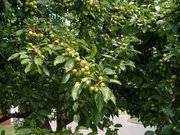Malus
|
|
| Malus - Apples and Crabapples | ||||||||||||||
|---|---|---|---|---|---|---|---|---|---|---|---|---|---|---|
 Malus flowers | ||||||||||||||
| Scientific classification | ||||||||||||||
| ||||||||||||||
| Species | ||||||||||||||
|
M. angustifolia - Southern Crab |
Malus, the apples, is a genus of about 30-35 species of small deciduous trees or shrubs in the family Rosaceae, including most importantly the domesticated Orchard or Table Apple (M. domestica, derived from M. sieversii). The other species are generally known as "wild apples", "crab apples", "crabapples" or "crabs", this name being derived from their small and sour, unpalatable fruit. The genus is native to the temperate zone of the Northern Hemisphere, in Europe, Asia and North America.
Apple trees are small, typically 4-12 m tall at maturity, with a dense, twiggy crown. The leaves are 3-10 cm long, alternate, simple, with a serrated margin. The flowers are borne in corymbs, and have five petals, which may be white, pink or red, and are perfect, with usually red stamens that produce copious pollen, and an inferior ovary; flowering occurs in the spring after 50-80 growing degree days. Apples require cross-pollination between individuals by insects (typically bees, which freely visit the flowers, for both nectar and pollen); all are self-sterile, and self-pollination is impossible making pollinating insects essential. The honeybee is the most effective pollinator of apples. Malus species, including domestic apples, hybridize freely.
Malus_fruit.jpg
The fruit is a globose pome, varying in size from 1-4 cm diameter in most of the wild species, to 6 cm in M. pumila, 8 cm in M. sieversii, and even larger in cultivated orchard apples. The centre of the fruit contains five carpels arranged star-like, each containing one to two (rarely three) seeds.
One species, Malus trilobata from southwest Asia, has three- to seven- lobed leaves (superficially resembling a maple leaf) and with several structural differences in the fruit; it is often treated in a genus of its own, as Eriolobus trilobatus.
Uses
For Malus domestica, see Apple. The fruit of the other species is not an important crop, being extremely sour and (in some species) woody, and is rarely eaten raw for this reason. However if crabapples are stewed and the pulp is carefully strained and mixed with an equal volume of sugar then boiled, their juice can be made into a delicious ruby-coloured crabapple jelly. A small percentage of crab apples in cider makes a more interesting flavour.
Crabapples are widely grown as ornamental trees, grown for their beautiful flowers or fruit, with numerous cultivars selected for these qualities and for resistance to disease.
Some crab apples are used as rootstocks for domestic apples to add beneficial characteristics. For example, Siberian crab rootstock is often used to give additional cold hardiness to the combined plant for orchards in cold northern areas.
They are also used as pollenizers in apple orchards. Varieties of crab apple are selected to bloom contemporaneously with the apple variety in an orchard planting, and the crabs are planted every sixth or seventh tree, or limbs of crab are grafted onto some of the apple trees. In emergencies a bucket or drum bouquet of crab apple flowering branches are placed near the beehives as orchard pollenizers. See also Fruit tree pollination.
External links
- Vermont Extension - Disease resistant crabapples (http://www.ext.vt.edu/departments/envirohort/articles/fruits_and_nuts/drescra.html)
- Ontario Ministry of Agriculture and Food - Crabapple pollenizers for apples (http://www.gov.on.ca/OMAFRA/english/crops/facts/00-011.htm)
- University of Georgia - Producing crabapple jelly (http://www.uga.edu/nchfp/how/can_07/crabapple_jelly.html)
- East of England Apples and Orchards Project (http://www.applesandorchards.org.uk)

